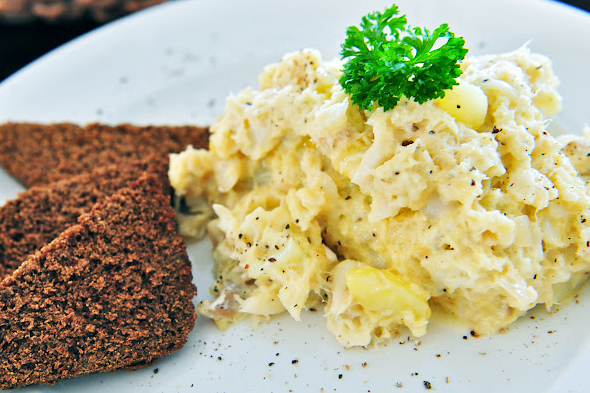The Flavours of Icelandic Cuisine

1. Fermented Shark
One of the most famous Icelandic dishes is fermented shark, known as hákarl. The process of preparing the shark involves burying it underground and leaving it to ferment for several months. The result is a pungent and ammonia-flavoured dish that is not for the faint-hearted.
2. Lamb
Lamb is a staple ingredient in Icelandic cuisine and is often served in stews or roasted. Icelandic lamb is known for its distinctive flavour due to the animal's grazing on the wild Icelandic landscape.
3. Seafood
As an island nation, it's no surprise that seafood plays a significant role in Icelandic cuisine. From fresh cod to langoustines, Icelandic seafood is of the highest quality and is often served in traditional dishes such as fish soup and fish stew.
4. Skyr
Skyr is a traditional Icelandic dairy product that is similar to yogurt but has a thicker consistency and higher protein content. Skyr is often served with fruit and is a popular breakfast option in Iceland.
5. Rye Bread
Traditional Icelandic rye bread is a dark, dense bread that is baked using geothermal heat. The bread has a slightly sweet flavour and is often served with smoked salmon or lamb.
Must-Try Icelandic Dishes

1. Plokkfiskur
Plokkfiskur is a traditional Icelandic fish stew that is made with boiled potatoes, onions, and cod. The stew is seasoned with herbs and spices and is often served with rye bread.
2. Hrútspungar
Hrútspungar, or ram's testicles, is a traditional Icelandic dish that is not for the faint-hearted. The dish is often pickled or smoked and is served as a delicacy.
3. Harðfiskur
Harðfiskur, or dried fish, is a staple ingredient in Icelandic cuisine. The fish is often eaten as a snack or served with butter and rye bread.
4. Brennivín
Brennivín is a traditional Icelandic schnapps that is made from fermented potato mash and flavoured with caraway seeds. The drink is often served alongside hákarl.
Top Rated Resteraunts In Reykjavik

-
Grillmarkadurinn - Located in the heart of Reykjavik, Grillmarkadurinn offers a unique dining experience that combines traditional Icelandic ingredients with modern culinary techniques. The menu features a range of meat and seafood dishes, as well as vegetarian options. Prices range from $30-$50 per dish.
-
Fiskfelagid - Situated in a historic building in downtown Reykjavik, Fiskfelagid offers a high-end dining experience that specializes in seafood. The menu features a range of fresh fish and seafood dishes, as well as vegetarian options. Prices range from $40-$80 per dish.
-
Matur og Drykkur - Located in a renovated fish factory in the trendy Grandi district of Reykjavik, Matur og Drykkur offers a modern take on traditional Icelandic cuisine. The menu features dishes that showcase the country's unique ingredients, such as lamb, fish, and fermented shark. Prices range from $25-$45 per dish.
-
Kopar - Situated in the old harbor of Reykjavik, Kopar offers a stunning waterfront setting and a menu that showcases the best of Icelandic seafood. The menu features a range of dishes that highlight local ingredients, such as lobster, langoustine, and arctic char. Prices range from $30-$60 per dish.
-
Dill - Located in the trendy Nordic House in Reykjavik, Dill offers a fine dining experience that focuses on seasonal and locally-sourced ingredients. The menu changes regularly to reflect the best of Iceland's produce, and features a range of meat, seafood, and vegetarian dishes. Prices range from $70-$100 for a multi-course tasting menu.
FAQs
-
Is Icelandic cuisine expensive? A: Iceland can be an expensive country for food due to its remote location and the cost of importing ingredients. However, there are many affordable options available, such as street food stalls and local markets.
-
What is hákarl? A: Hákarl is a traditional Icelandic dish made from fermented shark.
-
What is skyr? A: Skyr is a traditional Icelandic dairy product that is similar to yogurt but has a thicker consistency and higher protein content.
-
What is the best time to try Icelandic cuisine? A: Iceland's culinary scene is available year-round, but summer is the best time to try Icelandic seafood and lamb, which are in peak season during this time.
-
Is Icelandic cuisine suitable for vegetarians or vegans? A: While Icelandic cuisine is traditionally meat-based, there are vegetarian and vegan options available in most restaurants and cafes.
-
Are Icelandic dishes spicy? A: Icelandic cuisine is not known for its spiciness, but it does offer a range of unique and bold flavours that are sure to excite your taste buds.
-
What is the best way to experience Icelandic cuisine? A: The best way to experience Icelandic cuisine is to try traditional dishes in local restaurants and cafes. Food tours and markets are also a great way to explore Icelandic cuisine and learn more about the country's food culture.




